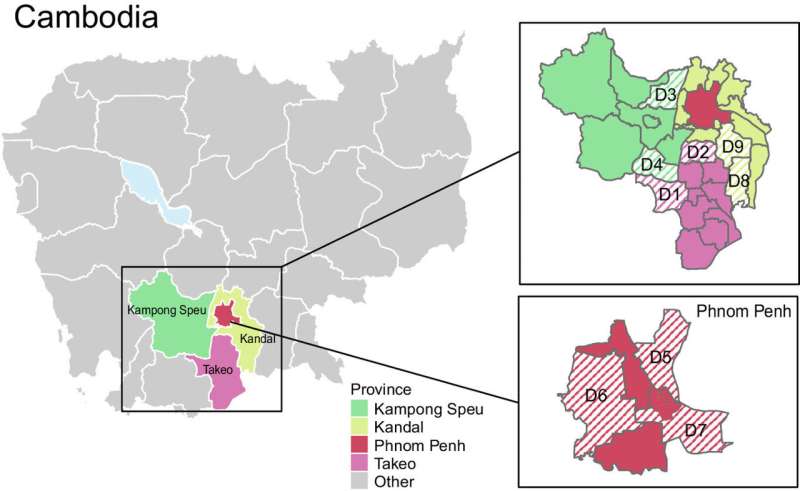This article has been reviewed according to Science X's editorial process and policies. Editors have highlighted the following attributes while ensuring the content's credibility:
fact-checked
peer-reviewed publication
trusted source
proofread
Scientists find new strains of influenza A virus in pigs, potentially posing a pandemic risk

Scientists from Duke-NUS Medical School and their collaborators have uncovered several previously unknown strains of swine flu viruses that have been circulating unnoticed in Cambodian pig populations over the past 15 years, potentially posing a pandemic risk. The strains include viruses that have been passed by humans to pigs, as well as some with genes originating from as far as North America.
The paper, published in the journal PNAS, makes the case for systematic surveillance to detect and warn of new strains of viruses early to prevent future pandemics.
The study, led by scientists Yvonne Su, Gavin Smith and Michael Zeller from the Emerging Infectious Diseases (EID) Program, identified genetically diverse pools of influenza A viruses co-circulating in pigs.
Pigs are a key intermediary in the emergence and potential spread of influenza viruses between animals and humans, the researchers noted, as they provide a suitable environment for the shuffling of gene segments between avian, swine and human hosts, ultimately giving rise to new viruses. With pork production dramatically increasing over the past 50 years, international trade and movement have further amplified the risks.
"The long-term evolution of different lineages has led to the establishment of genetically distinct viruses that have been continuously circulating in pig populations undetected for decades. Our study revealed the hidden and complex genomic landscape of swine flu virus evolution in Southeast Asia, marking the region as a hotspot for virus diversity and risk of new virus emergence," said Associate Professor Yvonne Su from Duke-NUS, a senior and corresponding author of the study.
In the study, Assoc Prof Su and her colleagues from Duke-NUS collaborated with counterparts from various institutions, including the National Animal Health and Production Research Institute, Phnom Penh, and London School of Hygiene & Tropical Medicine.
From March 2020 to July 2022, they conducted swine influenza surveillance in 18 pig slaughterhouses in Cambodia. They collected 4,089 nasal swabs from pigs in different districts of four provinces. Among these, 72 pigs—or around 2% of the pigs—tested positive for influenza A virus.
The scientists identified nine distinct swine influenza A virus groups, at least seven of which had not been detected for between two to 15 years.
Among these are multiple H3 lineages that had been passed by humans to pigs, circulating undetected for about 10 years; as well as the H1N1 subtype, which was predominant and likely derived from human origins dating back to the 2009 pandemic. Two seasonal viruses were detected in pigs from Kandal, Phnom Penh, and Takeo provinces, and likely originated from Thailand.
The team also isolated a new swine European H1N2 variant (that originally came from birds) with North American genes in Cambodia. While they were the first to detect this variant, their genomic analysis suggests that it had been circulating in pigs in the region since 2014, highlighting the need for better surveillance.
Delving deeper into the movement of viruses across geographical borders, the scientists found that European swine flu viruses had been sporadically introduced into South Central China and Southeast Asia in the early 2000s.
Genetic evidence indicated South Central China has served as the major source of European-like swine flu virus transmission in the region since around 2010, with the viruses subsequently spreading more widely across China and Southeast Asian countries such as Cambodia.
"While swine influenza viruses typically cause mild symptoms in pigs, they pose a pandemic threat to humans, as the human population may lack immunity or have inadequate protection against new strains of swine influenza viruses. Therefore, systematic surveillance is crucial in early detection and warning of new subtypes or strains," said Professor Gavin Smith, Director of the EID Program and an author of the study.
Further studies are needed to understand the pandemic threat of the new viruses, including how they react with human viruses and how easily they can spread. To this end, the team is currently developing a platform that can identify major swine flu genetic subtypes.
The screening will not be limited to swine and human subtypes but also include avian sequences. With the set up, they will be able to assess if pig and human populations have been infected with the influenza subtypes.
Professor Patrick Tan, Senior Vice-Dean for Research at Duke-NUS said, "Routine and sustained surveillance is indispensable in identifying new viruses so that their transmission risk can be assessed. It is therefore critical that more efficient and continuous surveillance methods are integrated with automated analytical tools to rapidly provide information on changes in human and animal pathogens."
"Such a system as the team at Duke-NUS is developing would improve animal health through selection of effective vaccines, and aid in human health by monitoring viruses with the potential for transmission."
More information: Michael A. Zeller et al, The genomic landscape of swine influenza A viruses in Southeast Asia, Proceedings of the National Academy of Sciences (2023). DOI: 10.1073/pnas.2301926120
Journal information: Proceedings of the National Academy of Sciences
Provided by Duke-NUS Medical School



















